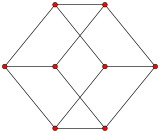Platonic graph
This article relies largely or entirely on a single source. (April 2024) |


In the mathematical field of graph theory, a Platonic graph is a graph that has one of the Platonic solids as its skeleton. There are 5 Platonic graphs, and all of them are regular, polyhedral (and therefore by necessity also 3-vertex-connected, vertex-transitive, edge-transitive and planar graphs), and also Hamiltonian graphs.[1]
- Tetrahedral graph – 4 vertices, 6 edges
- Octahedral graph – 6 vertices, 12 edges
- Cubical graph – 8 vertices, 12 edges
- Icosahedral graph – 12 vertices, 30 edges
- Dodecahedral graph – 20 vertices, 30 edges

|

|

|

|

|
See also[edit]
References[edit]
- ^ Read, R. C. and Wilson, R. J. An Atlas of Graphs, Oxford, England: Oxford University Press, 2004 reprint, Chapter 6 special graphs pp. 261, 266.
External links[edit]

